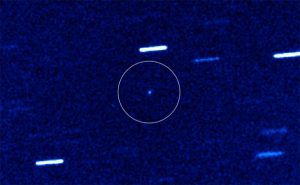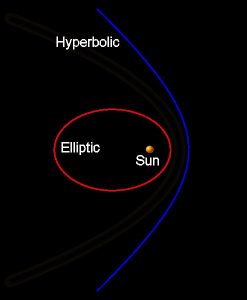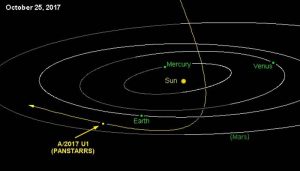Over the past twenty years or so NASA has been working on a effort to find and catalog all of the small objects in our Solar System that could one day pose a threat to us here on Earth. A critical part of this effort was the design and construction of telescopes especially suited to surveying large parts of the sky in very fine detail.
One of these telescopes is Pan-STARRS at the observatory atop Mona Kea in Hawaii. With a mirror of 1.8 meters in diameter the telescope is smaller than most professional instruments, but with a 1.4 Gigapixel camera Pan-STARRS can photograph the entire sky several times a month.
That’s what you need in order to find Near Earth Objects (NEOs). Take two pictures of the same part of the sky a couple of weeks apart and compare them. Anything that moves between the two images is an NEO.
Just a few weeks ago on October 19th, Doctor Rob Weryk of the University of Hawaii’s Institute for Astronomy found something special with the Pan-STARRS telescope. At first Dr. Weryk thought he’d just found another
space rock, there are literally thousands out there. Dr. Weryk gave the 500-meter rock the designation A/2017 U1.
When he calculated the object’s position and velocity however Doctor Weryk realized that whatever it was it was moving too fast to remain in orbit around the sun. The object was a visitor from interstellar space making its first and only trip around our Sun. The photograph below shows the small dot that is A/2019 U1.

Astronomers had long been expecting a visit from such an object. Many models of how solar systems form have a certain amount of matter being expelled as the star and planets condense. These outcasts would then wander between the stars where they could occasionally be drawn into the gravitational field of another star.
The orbits followed by these temporary visitors are not closed elliptical paths like those of planets or very comets but are an open-ended curve known as a hyperbola. Whereas the planets repeat the same orbit over and over again, an object on a hyperbolic trajectory is on a one time only orbit around a star. The figure below shows the difference between an elliptic and hyperbolic orbit.

A/2017 U1 made its closest approach to our Sun back on September 9th, more than a month before it was discovered. Coming within 23 million miles of our star A/2017 U1’s velocity increased to almost 90 kilometers per second. It passed within 15 million miles of Earth on October 14th at a velocity of 60 kps; three times the velocity that the New Horizons space probe had on its way to Pluto. In ten years or so, when it has left our Solar System behind A/2017 U1 will still have a velocity of about 25kps, faster than that of the Voyager I space probe, the first man made object to leave our Solar System. The image below shows the path of A/2017 U1 as it swung around the Sun.

So, what was A/2017 U1? What was it made of? Where did it come from?
To be honest we didn’t learn a great deal about A/2017 U1. It was very small, didn’t come that close and is already too far away for even the most powerful telescopes to see anymore. Really all we know for certain is that A/2017 U1 came from the direction of the constellation of Lyra and that it looked more like an asteroid than a comet.
But we know it came from the beyond, from outside out little neighborhood of the Galaxy. And that means there will be others, and each time one visits we will learn a little more about them. That’s the way science works after all.

very informative post for me as I am always looking for new content that can help me and my knowledge grow better.
Happy to be of service and I hope you’ll be back real soon.
Bob L